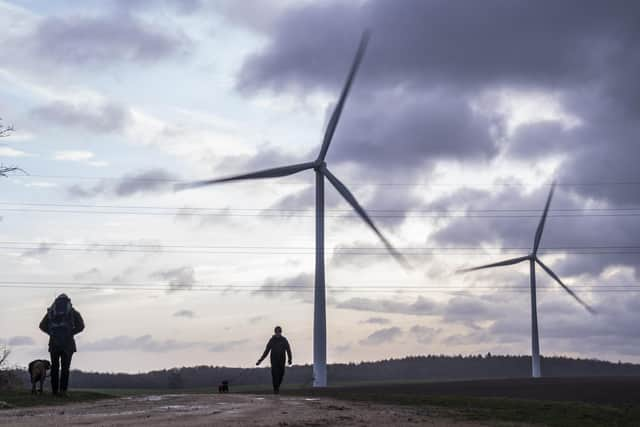Power cuts are the most likely outcome if we completely phase out gas - Bill Carmichael
It is this - if we are to rely on renewable energy for all of our energy needs in the future, what happens when the sun doesn’t shine and the wind doesn’t blow?
I have yet to hear a convincing or even coherent answer to this question. All you get is some frantic hand waving, and vague suggestions that battery storage or pumped hydropower could be the answer.
Advertisement
Hide AdAdvertisement
Hide AdThe word ‘could’ is doing a lot of work here. Battery technology is still in the development stage, and has not been even tested on the scale required, and the costs would be massive. Pumped hydropower storage is a proven technology, but would require decades of large scale and expensive construction work that hasn’t even begun yet.


The more honest answer is that if we phase out gas, coal and nuclear, we simply don’t know where our power will come from in the future, and power cuts are the most likely outcome.
Don’t get me wrong, the move to renewables has been an undoubted success story. On a good day wind and solar power can produce around 40 per cent of the UK’s energy needs
Consumption of coal is 150 times lower than the peak in 1913, and coal production is now at a level last seen more than 300 years ago.
Advertisement
Hide AdAdvertisement
Hide AdAs a result the UK became the first major economy in the world to halve greenhouse gas emissions, cutting them by 50 per cent between 1990 and 2022. As a nation we can be immensely proud of our record in fighting climate change.
So, solar and wind energy will remain a vital part of our energy production - but under current technologies they cannot be the only answer. The hard reality is that the weather is fickle, and that means renewable energy will always be unreliable and intermittent, and needs to be backed up by fossil fuels and nuclear.
Let me show you why this is the case. On a still, freezing cold night last December, I visited a website where you can see details of the UK’s energy production in real time. The total contribution from renewable energy sources such as wind and hydro was 3.36GW or less than 8 per cent of demand. It was night, so of course solar was providing nothing.
Without the contribution of coal, gas and nuclear on that particular night 92 per cent of energy demand would be unmet - and that would mean widespread and devastating power cuts.
Advertisement
Hide AdAdvertisement
Hide AdI am old enough to remember the power cuts of the 1970s during the miners’ strike. It was a pretty miserable experience studying for my A Levels by candlelight. Today, with our increased reliance on electronic gadgetry, the impact would be much greater.
That is why the government’s announcement this week that new gas-fired power stations should be built was absolutely necessary, and why criticism of the move was so misguided. The government said the new stations will replace existing plants, many of which are ageing and will soon be retired.
Prime Minister Rishi Sunak said the new gas power stations were needed to provide a reliable and affordable back-up for days when renewables did not deliver, and would provide an energy source independent of dictators like Vladimir Putin.
He said: “It is the insurance policy Britain needs to protect our energy security, while we deliver our net zero transition.“
Advertisement
Hide AdAdvertisement
Hide AdThe new plants will be built by private investors and will be capable of operating efficiently for just an hour or two at a time to fill in the gaps from other power sources.
They will be capable of being retrofitted to burn hydrogen, or fitted out with carbon capture and storage technologies in the future.
The government is also right in expanding nuclear power. Currently our nine nuclear reactors generate about 15 per cent of our energy needs, but many of these plants are ageing and will be retired in the coming years.
The government has announced plans to build an additional 24GW of nuclear power plants by 2050 to provide 25 per cent of our energy needs.
Advertisement
Hide AdAdvertisement
Hide AdEnvironmentalists and green lobby groups oppose all of this. They don’t like us burning coal and are against new gas-fired and low-carbon nuclear plants for ideological reasons. But ask them where our energy will come from on a cold, still winter’s night?
Comment Guidelines
National World encourages reader discussion on our stories. User feedback, insights and back-and-forth exchanges add a rich layer of context to reporting. Please review our Community Guidelines before commenting.